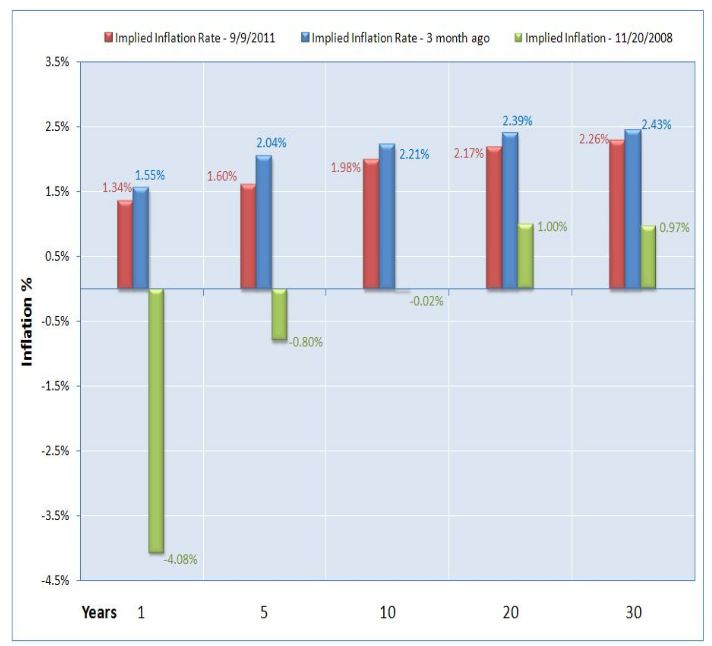 Author: Atlas Capital
Author: Atlas Capital
Covestor model: Broad ETF
Over the last 3 months, U.S. Treasury yields have fallen in sympathy with rising European sovereign fears and concern over a faltering U.S. economy. The term structure of interest rates, also known as the yield curve, has experienced a marked flattening in this period.
What’s thought provoking is that Treasury Inflation Protected Securities [TIPS] have also rallied like nominal U.S. Treasury bonds. Keep in mind that these two securities are basically different asset classes: one offers an income stream and the other offers a small coupon along with protection against rising inflation (as measured by CPI-U, Consumer Price Index for Urban consumers) payable at maturity. The mathematical characteristics and risks associated with each security are drastically different. Of course, this is the first time that Treasury rates, in particular 10 year rates, have been this low since the Treasury Department introduced TIPS in 1997. This graph offers some interesting insights – click to enlarge:

The red-line signifies the yield on the nominal 10 year US Treasury Note. The blue-line signifies the 10 year TIPS yield without any inflation adjustment accrual. Hence, if inflation for the next 10 years is zero, today’s investor will earn an annualized real rate of return of minus 0.05%. That’s less than zero. For argument’s sake, let’s just conclude the investor earns nothing for 10 years. The difference between the nominal yield on 10 year Treasury Notes and the non-inflation accrual adjusted 10 year TIPS yield is represented by the green-line. This line represents the breakeven rate of inflation required for an investor to be indifferent to owning either security. If the measured level of average annual inflation is less than the breakeven rate, the investor would be better off owning the nominal Treasury Note; vice-versa if actual inflation is greater than the breakeven rate. The nature of TIPS allows for the investor not to experience deflation (i.e., negative inflation). If measured inflation is less than zero, the investor simply earns the small coupon and receives their principal at maturity.
So why would an investor accept such a low locked-in real rate of return? Let’s look at buyer motivations. A large component of buyers is price inelastic – they buy indiscriminately for reasons like asset/liability hedging, duration hedging, etc. Another group of buyers is made up of speculators who are betting on the economy and the direction of interest rates. There is widespread conjecture that the next arrow in the Federal Reserve’s quiver (to be seen as part of Quantitative Easing Trois, QE3) will be heavier buying of long dated Treasury securities than seen in QE1 or QE2; so some buy in anticipation of this increased demand.
A third group of buyers falls under the heading of “inflation hedgers”. This group sees unsustainable fiscal imbalances and recognizes there are three ways out of the quagmire: cut spending, raise taxes, or monetize debt. We believe the first two options are either too expensive politically or ineffective, leaving the latter as the only realistic outcome. Monetize debt and you effectively degrade the purchasing power of the currency. In other words, inflate away your problems. The buyer of TIPS today is explicitly betting that inflation over the next 10 years will average more than the current implied 1.98% breakeven rate. We think that’s a good bet.
In fact, as you extend maturity, implied breakeven rates of inflation are still modestly low. See the chart below. Note how low breakeven rates were at the height of the financial crisis in November 2008. At that time, market participants were convinced we’d have a significant deflationary future. Not so today.

With these observations on the table, you might wonder – why not significantly overweight TIPS in a world where nominal yields are so low? Well, for one, we are not convinced that reported year over year changes in CPI-U are appropriately indicative of real inflation. Fully 41.5% of the index is comprised of “Housing” in the form of owner’s equivalent rent (OER). OER is a statistical fabrication created to recognize the enormous stock of domestic home ownership. The component attempts to reflect changes in the “implicit cost” of renting the owned house. Huh? We appreciate the intent, but the figure is really akin to an educated guess, not the actual price change of an item.
Additionally, we are always suspicious of incentives and government bureaucracies. CPI–U is a statistic measured and reported by the BLS (U.S. Bureau of Labor Statistics). Over the years, the makeup of the index and its component weighting has evolved, in theory, to more appropriately reflect changes in societal expenditures. However, there have been periods when changes have been made to satisfy political initiatives (under the Johnson, Nixon and Clinton administrations). CPI-U is the basis for almost all government benefit cost of living adjustments (think social security). There is a natural incentive for politicians to keep reported inflation low. We are not saying the process is fraudulent, but rather it is an imperfect approximation.
We believe that TIPS have a significant place in portfolios to protect against inflationary erosion of the monetary base. To augment protection against inflation, investors need also own “physical stuff” that has universal appeal; physical assets like land and housing.
Best,
Jono Tunney
Atlas Capital Advisors LLC

